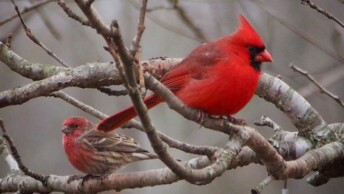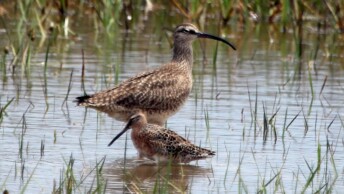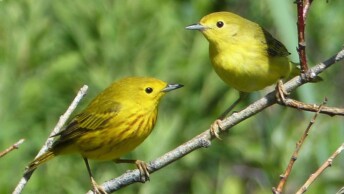Geese are a familiar and cherished sight across Oregon’s diverse landscapes, from coastal wetlands to agricultural fields and even urban parks. As they migrate through the state, many species of geese find Oregon’s rich waterways and open spaces ideal for resting, feeding, and raising their young.
Species like the Canada Goose and Snow Goose can be seen in large flocks, filling the air with their distinctive calls as they journey along the Pacific Flyway. Some, like the Dusky Canada Goose, rely specifically on Oregon’s unique habitats during their wintering period. For residents and bird watchers alike, geese are a sign of seasonal change and a reminder of the natural rhythms that shape the state’s wildlife.
Whether they’re gliding gracefully across lakes or feeding in grassy fields, geese in Oregon offer a connection to nature that is both dynamic and ever-present, adding life to the state’s beautiful landscapes year-round.
1. Canada Goose
- Scientific name: Branta canadensis
- Life span: 10-25 years
- Size: 30-43 in / 76-110 cm
- Weight: 7-14 lbs / 3-6.4 kg
- Wingspan: 50-71 in / 127-180 cm
- Status: Least Concern
- State status: Breeding and common
- Migration pattern: Many stay year-round; some migrate south in winter
The Canada Goose is one of the most familiar waterfowl in North America, found across a broad range from the Arctic tundra to the southern United States. In Oregon, they are both year-round residents and migratory visitors, favouring lakes, rivers, and open fields. These geese are easily recognized by their long black necks and distinctive white cheek patches.
Their bodies are typically gray-brown, with a lighter chest and belly, creating a contrast against their darker wings. Their V-shaped flight formations and loud honking calls are iconic sights and sounds during migration. Canada Geese have adapted well to both wild and urban settings, making them a common sight throughout Oregon’s parks and waterways.
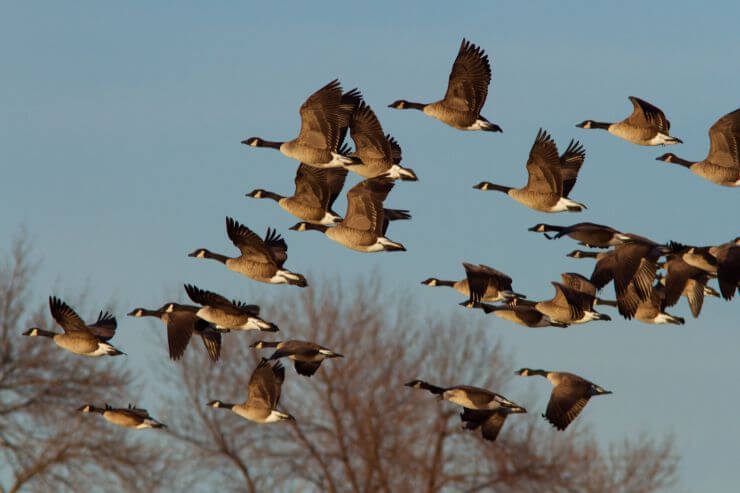
Canada Geese are known for their strong attachment to nesting sites, often returning to the same location year after year. They typically build their nests near water, such as ponds, lakes, and rivers, using reeds, grasses, and down feathers to create a cozy, well-insulated nest. The female is the primary builder, while the male stands guard to protect the territory.
Nests are often placed on elevated ground to avoid flooding and provide a clear view of potential predators. Once the nest is ready, the female lays a clutch of 4-7 eggs, which she incubates for about 25-30 days. During this period, the male remains vigilant, chasing off intruders and keeping a close eye on the surroundings, ensuring the safety of the family.
Canada Geese have a varied diet that shifts with the seasons. In spring and summer, they graze on grasses, sedges, and aquatic plants, foraging in fields and along water edges. As fall and winter approach, they often move to agricultural areas to feed on grains, such as corn and wheat, left behind after harvest.
Their ability to digest a range of plant material allows them to thrive in diverse environments, from wild wetlands to urban parks. In urban areas, Canada Geese can often be seen nibbling on lawns and enjoying the abundant greenery. Their dietary adaptability has helped them expand their range, making them a familiar sight in many parts of Oregon, where they can find food sources year-round.
Canada Geese were once in decline due to overhunting and habitat loss in the early 20th century, but concerted conservation efforts have led to a significant recovery. Through habitat protection, regulated hunting, and active management programs, their numbers have rebounded, especially in regions like Oregon.
Their adaptability to urban environments has also played a role in their resurgence, allowing them to establish new populations in city parks and golf courses. Today, Canada Geese are common in many areas, sometimes even causing conflicts due to their increasing presence in urban spaces. Wildlife managers continue to work on balancing their populations to minimize human-wildlife conflicts while ensuring their habitats remain healthy.
2. Snow Goose
- Scientific name: Anser caerulescens
- Life span: 3-15 years
- Size: 25-32 in / 64-81 cm
- Weight: 3.2-6.5 lbs / 1.5-3 kg
- Wingspan: 53-63 in / 135-160 cm
- Status: Least Concern
- State status: Migratory and common
- Migration pattern: Leaves Oregon in late fall, heads south to wintering areas
Snow Geese are striking birds, with bright white plumage contrasted by black wingtips that are especially visible in flight. They have a distinctive “grinning patch” on their pink bills, giving them a unique expression. Snow Geese breed in the Arctic tundra and migrate south during winter, with large flocks passing through Oregon each year.
They often gather in vast numbers in wetlands and agricultural fields, creating impressive displays as they take off or land in unison. During migration, their presence is hard to miss, with their loud, high-pitched calls echoing over Oregon’s open landscapes. These geese bring a dynamic energy to the wetlands they visit, making them a highlight of the migration season.

Snow Geese nest in large colonies in the remote Arctic tundra, where their breeding season is short and intense. The female builds a nest on the ground, using grasses, moss, and down feathers to create a warm, insulated space. Nests are often placed near water sources, providing easy access for feeding and drinking.
Once the nest is ready, the female lays 3-5 eggs, which she incubates for about three weeks while the male guards the territory. In these vast breeding colonies, the sight of hundreds or even thousands of nests clustered together is a remarkable spectacle. The parents remain fiercely protective of their young, guiding the goslings to feeding areas as soon as they hatch.
Snow Geese primarily feed on plant material, with their diet consisting of roots, shoots, and grasses. During their time in the Arctic breeding grounds, they forage for sedges and other tundra vegetation. As they migrate south, they switch to feeding on agricultural crops like rice, corn, and wheat, taking advantage of the leftover grains in harvested fields. Their feeding behaviour often involves grubbing for roots and tubers, leaving behind distinctive foraging marks.
In Oregon, they gather in large flocks, feeding on grasses and grains, sometimes creating striking scenes as they move across fields in synchronized waves. Their adaptable feeding habits allow them to find sustenance along their migratory routes, ensuring they have the energy for their long journeys.
Snow Geese have seen a remarkable recovery over the past several decades, thanks to changes in agricultural practices and protected areas along their migration routes. Historically, their populations were affected by hunting and habitat loss, but with regulated hunting and conservation areas in place, their numbers have rebounded.
Today, Snow Geese are sometimes considered overabundant, with their large populations putting pressure on Arctic breeding grounds and certain wintering areas. In Oregon, wildlife managers monitor their presence to balance their impact on local ecosystems. The efforts to maintain healthy habitats along migration corridors help ensure that these large flocks continue to thrive while minimizing ecological impacts.
3. Greater White-fronted Goose
- Scientific name: Anser albifrons
- Life span: 15-20 years
- Size: 20-30 in / 51-76 cm
- Weight: 2.7-6.6 lbs / 1.2-3 kg
- Wingspan: 43-59 in / 110-150 cm
- Status: Least Concern
- State status: Migratory and common
- Migration pattern: Migrates south from Oregon in fall; returns in spring
The Greater White-fronted Goose is easily recognized by the white patch at the base of its pinkish bill, along with the speckled markings on its belly. Its plumage is mostly gray-brown, with a lighter underbelly and a white band near its tail. This goose breeds in the Arctic tundra and migrates south for the winter, often stopping in Oregon’s wetlands and agricultural areas along the way.
It’s known for forming large flocks during migration, where its distinctive high-pitched calls can be heard echoing across open spaces. The Greater White-fronted Goose is a welcome sight during the colder months, adding diversity to the waterfowl gatherings throughout the state’s refuges and fields.
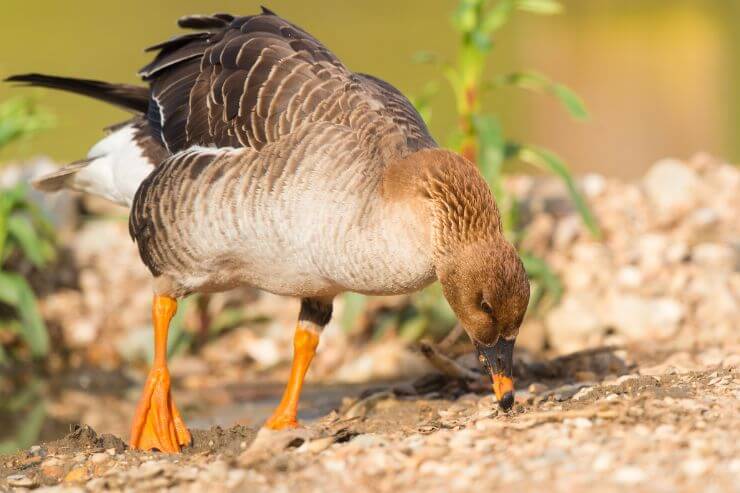
Greater White-fronted Geese nest in the Arctic tundra, often choosing areas near lakes, rivers, and marshes. The female builds a shallow nest using grasses and down feathers to create a warm, insulated space for her eggs. She lays 3-6 eggs and incubates them for about 25 days while the male stands guard.
Nests are typically placed in locations with a good view of the surroundings, allowing the geese to spot predators from a distance. Once the eggs hatch, the goslings are led to nearby water sources, where they feed and grow rapidly during the short Arctic summer. The family stays together, providing the young with protection until they are ready to migrate south.
The diet of the Greater White-fronted Goose varies seasonally and is primarily plant-based. During their Arctic breeding season, they feed on sedges, grasses, and aquatic plants found in the tundra. As they migrate south to wintering grounds, including regions like Oregon, they shift their diet to take advantage of agricultural fields, feeding on grains like wheat, barley, and corn.
They are efficient foragers, often seen grazing in open fields or probing for roots and tubers. In Oregon, they gather in flocks during migration, taking advantage of wetlands and harvested fields for sustenance. Their adaptability in diet helps them thrive across a wide range of habitats throughout their journey.
The Greater White-fronted Goose has seen varying population trends over the years, but overall, their numbers have been stable, thanks in part to effective conservation efforts. These efforts include protecting key wetland habitats along migration routes and enforcing hunting regulations to prevent overharvesting.
In Oregon, where they stop during migration, wildlife refuges play a crucial role in providing safe resting and feeding areas. Conservationists work to preserve these important habitats, ensuring that these geese can complete their long migrations successfully. Their presence in large flocks during winter is a testament to the success of habitat protection efforts, allowing birdwatchers to enjoy the sight of these distinctive geese in Oregon’s fields and wetlands.
4. Brant Goose
- Scientific name: Branta bernicla
- Life span: 10-20 years
- Size: 21-25 in / 53-64 cm
- Weight: 2.2-4.6 lbs / 1-2.1 kg
- Wingspan: 40-45 in / 102-114 cm
- Status: Least Concern
- State status: Migratory and uncommon
- Migration pattern: Winters on coast; migrates north in spring
The Brant is a small, dark-coloured goose that stands out with its sleek, compact appearance. It has a black head, neck, and chest, accented by a small white necklace-like marking on the upper neck. Its body is darker than other geese, with a lighter belly and grayish-brown back.
The Brant breeds in the high Arctic and migrates to coastal areas for the winter, with some groups making their way to Oregon’s coastal estuaries and bays. Here, they can be seen resting or feeding along the shorelines, often in tight-knit flocks. Their presence adds a touch of wildness to Oregon’s coastal landscapes, especially when they gather in the sheltered waters of bays and inlets.

Brant geese breed in the harsh conditions of the Arctic, preferring coastal tundra near river deltas and estuaries. They build their nests on the ground, typically using grasses, moss, and down to create a warm, insulated space for their eggs. The female lays 3-5 eggs and incubates them for about 24-26 days, while the male remains nearby to protect the nesting area.
The short Arctic summer means that the goslings must hatch quickly and start feeding to gain strength before their migration south. The family remains close together, and the young learn to swim and forage soon after hatching. Their breeding grounds are remote, adding to the challenge of studying their nesting behaviour.
The diet of the Brant is closely tied to their coastal habitats, both in breeding and wintering grounds. During the breeding season in the Arctic, they graze on grasses and sedges. However, they are most famous for their reliance on marine vegetation, particularly eelgrass and sea lettuce, which they feed on during the winter months.
In Oregon, Brant are often seen along the coast in bays and estuaries, where they forage in shallow waters for aquatic plants. Their diet is highly specialized, making them dependent on the health of coastal ecosystems. Their preference for specific food sources like eelgrass makes them vulnerable to changes in their coastal habitats, making conservation of these areas crucial.
Brant populations have fluctuated over the years, often reflecting changes in the availability of their critical food sources, such as eelgrass beds. Conservation efforts have focused on protecting and restoring these vital coastal habitats. In Oregon, estuarine reserves and protected bays provide important wintering grounds for Brant, allowing them to find food and shelter. Conservationists also monitor their populations closely to ensure that hunting remains sustainable and that their habitats are not threatened by development.
Climate change and habitat degradation pose challenges for Brant populations, but coordinated efforts to protect their wintering and breeding grounds have helped stabilize numbers. Their presence along Oregon’s coasts is a reminder of the delicate balance required to maintain these specialized waterfowl populations.
5. Ross’s Goose
- Scientific name: Anser rossii
- Life span: 10-12 years
- Size: 20-25 in / 51-64 cm
- Weight: 2.2-3.6 lbs / 1-1.6 kg
- Wingspan: 37-43 in / 94-110 cm
- Status: Least Concern
- State status: Migratory and rare
- Migration pattern: Leaves Oregon in fall, migrates to southern wintering grounds
Ross’s Goose is a small, white goose that closely resembles the Snow Goose but can be distinguished by its shorter bill and lack of a “grinning patch.” Its plumage is pure white with black wingtips that are visible in flight. This species breeds in the high Arctic and migrates south to winter in the southern United States. In Oregon, it is seen primarily during migration, often mixed in with larger flocks of Snow Geese.
Ross’s Geese are less common than their relatives, making sightings a special event for bird watchers. Their compact build and delicate appearance add a touch of elegance to the flocks they join as they move through the state’s wetlands and fields.
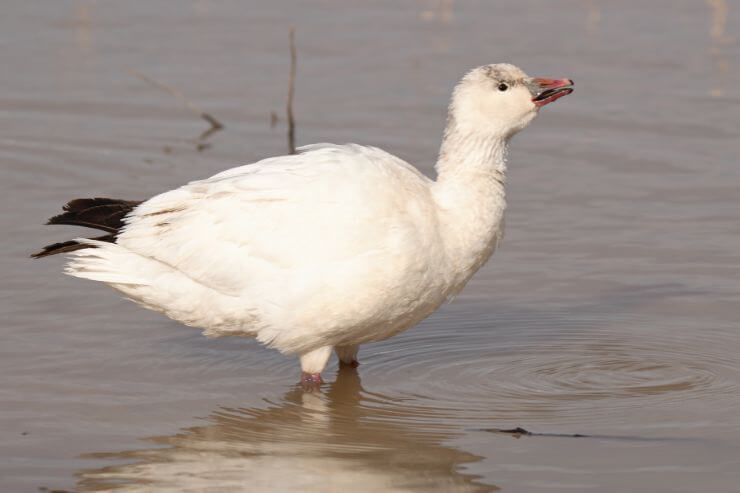
Ross’s Geese nest in the high Arctic, favouring areas near lakes and ponds for their breeding sites. Unlike their larger relatives, they tend to nest in smaller colonies or even as isolated pairs. The female constructs a shallow nest on the ground using grasses, moss, and down feathers to line the interior, providing warmth for the eggs. She typically lays 3-5 eggs, which are incubated for about 23-25 days.
During this time, the male keeps a watchful eye on the surrounding area, alert to potential threats. The breeding season is short, and once the goslings hatch, the family quickly moves to nearby feeding areas to take advantage of the summer’s brief abundance.
Ross’s Geese have a diet that closely mirrors that of the Snow Goose, consisting largely of plant material. In their Arctic breeding grounds, they feed on grasses, sedges, and other tundra vegetation. During migration and winter, they shift to feeding on agricultural grains, such as wheat, corn, and barley, often alongside larger flocks of Snow Geese.
Their feeding habits help them store the necessary energy for long migratory flights. In Oregon, they are sometimes seen in mixed flocks with Snow Geese, foraging in fields and wetlands. Despite their smaller size, Ross’s Geese are efficient foragers, quickly stripping fields of leftover grains and grasses before moving on.
Ross’s Geese have experienced a positive conservation trend over the past few decades, with their populations growing steadily. They were once considered rare, but efforts to protect their breeding grounds in the Arctic and manage their wintering habitats have contributed to their recovery. Today, they are often seen in large flocks with Snow Geese, particularly during migration. Conservation efforts have focused on maintaining protected areas along their migratory paths and ensuring sustainable hunting practices.
In Oregon, their presence is still more occasional than that of Snow Geese, but the sight of a Ross’s Goose among a flock is always a welcome one for bird enthusiasts. These efforts have helped secure a stable future for this smaller, charming goose.
6. Swan Goose
- Scientific name: Anser cygnoides
- Life span: 10-15 years
- Size: 30-37 in (76-94 cm)
- Weight: 5.5-8.8 lbs (2.5-4 kg)
- Wingspan: 59-70 in (150-178 cm)
- Status: Vulnerable
- State status: Non-native and rare (domestic and escaped populations only)
- Migration pattern: Rare in Oregon; seen occasionally during migrations.
The Swan Goose, native to East Asia, is a large and striking waterfowl with a long, slender neck and a distinctive orange or pinkish bill. Unlike other geese, its neck is slightly more elongated, giving it a swan-like appearance. It has a brownish-gray body with a lighter chest and a darker stripe running down the back of its neck.
While naturally found in Asia, in Oregon, Swan Geese are generally seen as domesticated or escaped individuals, rather than part of wild populations. They occasionally appear in ponds and lakes where domestic waterfowl are kept. Seeing a Swan Goose in Oregon can be a surprise, adding an unexpected touch of exotic beauty among the more common waterfowl species.

Swan Geese are native to East Asia, where they nest in wetlands and along riverbanks. They typically choose sites near water, building their nests on elevated ground or islands to protect against flooding. The female constructs a simple nest using reeds, grasses, and down feathers, laying 5-8 eggs. She incubates the eggs for about 28-30 days while the male stands guard nearby.
Their nesting season aligns with the warmer months, allowing the young to grow before the colder season sets in. While they are not naturally found in North America, domesticated Swan Geese can sometimes be seen nesting in parks or ponds in Oregon, where they exhibit similar nesting behaviours to their wild counterparts.
In the wild, Swan Geese feed primarily on grasses, sedges, and aquatic plants, grazing along riverbanks and wetland edges. They use their strong bills to pull up roots and tubers, making them efficient foragers. Domesticated and feral populations in places like Oregon may also eat grains and other food sources provided by humans or found in urban settings. Their diet makes them well-suited to life in wetland areas, where they can find ample vegetation.
In Oregon, they may be seen foraging in parks or near ponds, taking advantage of both natural and supplemental food sources. Their herbivorous diet supports their strong, robust build and is similar to that of other geese species.
The wild populations of Swan Geese have faced significant declines due to habitat loss and overhunting in their native range across East Asia. International conservation efforts have focused on protecting their natural wetlands and regulating hunting to prevent further losses. In Oregon, however, the Swan Goose is seen as an introduced species, usually as part of domesticated populations. These birds are often found in urban and rural areas, where they have adapted to local ponds and lakes.
Conservation efforts in the United States are more focused on managing domesticated populations and ensuring they do not negatively impact local ecosystems. The presence of Swan Geese in Oregon is a reminder of the global reach of conservation issues and the connections between species and habitats across continents.
7. Greylag Goose
- Scientific name: Anser anser
- Life span: 10-20 years
- Size: 29-36 in (74-91 cm)
- Weight: 6.2-8.8 lbs (2.8-4 kg)
- Wingspan: 57-71 in (145-180 cm)
- Status: Least Concern
- State status: Non-native and rare (domestic and escaped populations only)
- Migration pattern: Rare visitor in Oregon; occasionally seen during migrations.
The Greylag Goose is the ancestor of many domestic goose breeds, but wild populations can still be found across Europe and parts of Asia. In appearance, it has a bulky, sturdy body with gray-brown plumage and a characteristic orange or pinkish bill. Its wings and back have a lighter gray tone, which contrasts with its darker head and neck. In Oregon, sightings of Greylag Geese are usually of domesticated or feral birds, often seen around ponds and lakes in urban parks or rural areas.
They are not naturally part of North America’s wild goose populations, but their presence among mixed flocks can add a bit of variety to local waterfowl. Their robust build and domestic origins make them stand out from native species, offering a glimpse of the history behind domestic waterfowl.

Greylag Geese nest in a variety of habitats, including wetlands, marshes, and riverbanks, where they build their nests out of reeds, grasses, and down feathers. The nests are often placed near water, providing easy access to food and a natural defense against ground predators. The female lays 4-6 eggs, which she incubates for about 27-28 days, while the male keeps a close watch nearby.
Their nests are usually well-hidden among vegetation, providing protection and insulation. In Oregon, Greylag Geese are more commonly found as domesticated or feral birds, and they may nest in similar environments like ponds or lakes in parks, adapting their natural nesting behaviours to more human-influenced settings.
Greylag Geese have a varied diet that consists primarily of grasses, aquatic plants, and other vegetation. They graze on fields, meadows, and along the edges of water bodies, using their strong bills to pull up roots and stems. In areas where they are domesticated or have established feral populations, such as in Oregon, they also feed on grains and other human-provided food sources.
Their feeding habits make them adaptable to a range of environments, from wild wetlands to urban parks. Their grazing can have a significant impact on local vegetation, particularly when large flocks gather in one area. Despite this, their role in maintaining wetland ecosystems remains important.
The Greylag Goose has a rich history as the ancestor of most domestic goose breeds, and its wild populations are found across Europe and parts of Asia. While the species is not native to North America, feral populations of Greylag Geese are sometimes found in Oregon, usually originating from domesticated stock. Conservation efforts in their native range focus on protecting wetland habitats and managing hunting pressures to ensure their wild populations remain stable.
In Oregon, their presence as a non-native species means that conservation efforts are more about monitoring their impact on local ecosystems. Balancing their existence with native species is key to ensuring that they do not become invasive while allowing them to coexist in urban and rural areas. Their history as a domesticated bird highlights the complex relationship between humans and wildlife over centuries.
8. Cackling Goose
- Scientific name: Branta hutchinsii
- Life span: 6-10 years
- Size: 16-22 in / 41-56 cm
- Weight: 1.7-3.7 lbs / 0.8-1.7 kg
- Wingspan: 22-31 in / 56-79 cm
- Status: Least Concern
- State status: Migratory and common
- Migration pattern: Migrates south in fall, some winter in western Oregon
The Cackling Goose looks much like a smaller version of the Canada Goose, but it has a shorter neck and a more petite bill. It is native to North America, breeding in the tundra regions of Alaska and northern Canada before migrating southward for the winter. In Oregon, Cackling Geese are often seen mingling with Canada Geese in wetlands, fields, and along riverbanks.
Their calls are higher-pitched and more rapid than those of Canada Geese, giving them their distinctive name. Their plumage features similar colors, with a dark head, white cheek patch, and brownish-gray body. Despite their similarities, the smaller size and unique vocalizations of Cackling Geese make them an interesting find during Oregon’s migration season.
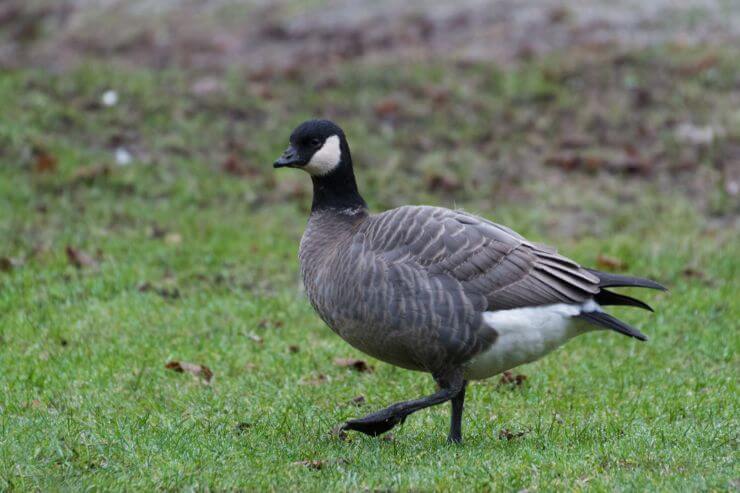
Cackling Geese nest in the tundra regions of Alaska and northern Canada, where they select sheltered spots on the ground near water. The female builds a nest out of grasses, moss, and down feathers, which insulate the eggs from the cold ground. She typically lays 3-5 eggs, which are incubated for around 25 days.
The male stands guard nearby, watching for predators like Arctic foxes and gulls. Once the goslings hatch, they quickly leave the nest and begin following their parents to nearby feeding grounds. The short Arctic summer requires the family to be on the move, taking advantage of the brief abundance of food to grow quickly before their migration south.
The diet of the Cackling Goose is similar to that of the Canada Goose, consisting mainly of grasses, sedges, and aquatic plants. During their breeding season in the Arctic, they graze on young shoots and other tundra vegetation. As they migrate to wintering grounds, including Oregon, their diet shifts to include grains from agricultural fields, such as corn and wheat.
Their foraging habits allow them to adapt to different environments, making use of whatever plant material is available. In Oregon’s wetlands and fields, they can often be seen feeding alongside other geese, using their small size and quick movements to find food even in crowded areas.
Cackling Geese were once considered a subspecies of the Canada Goose but were classified as a separate species in 2004 due to differences in size, behaviour, and vocalizations. This change has led to a better understanding of their unique needs and migratory patterns. Their populations are currently stable, but they face challenges from habitat loss in both breeding and wintering areas.
Conservation efforts focus on protecting key wetlands and maintaining healthy migration corridors. In Oregon, where they are a common winter visitor, wildlife managers work to ensure suitable habitats are available for both Cackling Geese and other waterfowl species. This helps maintain their numbers and supports the delicate balance of migratory bird populations.
Where to find Geese in Oregon
Finding geese in Oregon is a rewarding experience, as the state’s diverse habitats make it a key stopover for migrating flocks. To see these birds up close, head to areas with wetlands, lakes, and open fields where they gather to rest and feed.
Early mornings or late afternoons are the best times, when the birds are most active. Bringing binoculars can help you spot flocks from a distance without disturbing them, and warm layers are recommended as you’ll often find yourself near water.
Here are four great places to see geese in Oregon:
- Sauvie Island Wildlife Area near Portland is a top spot. Each winter, thousands of geese, including Canada and Snow Geese, fill its wetlands and open fields, creating a spectacular sight.
- Klamath Basin National Wildlife Refuge Complex is another prime destination. Situated along the Oregon-California border, it attracts huge flocks during migration, offering stunning views of geese against the backdrop of the surrounding mountains.
- Summer Lake Wildlife Area in south-central Oregon is a hotspot for waterfowl, especially during the spring and fall migrations, when you can see large gatherings of geese.
- Finley National Wildlife Refuge near Corvallis is ideal for winter viewing. It’s a haven for the Canada Goose, which winters in the Willamette Valley.
Conclusion
Geese in Oregon play a vital role in the state’s diverse ecosystems, from coastal estuaries to inland wetlands. Their seasonal migrations and varied species bring dynamic changes to the landscape, offering opportunities for birdwatchers and reminding us of the importance of preserving habitats that support these resilient and fascinating birds.

